NorthEast Radio Watch 11/18/2024: Sims Gets Yankees Callup
In this week’s issue… Yankees hire Dave Sims - Wallace, Maxwell move in NYC - Gray cuts news in Maine - Remembering CT's Pinto By SCOTT FYBUSH Jump to: ME - NH - VT - MA - RI - CT...
Over the years, we”ve chronicled many of the interesting AM sites in and around Los Angeles, but until April 2010, one of the most unusual sites eluded us. Sure, we”d seen the KRLA (870) site up on Eagle Rock in Glendale plenty of times while driving around the area, but we”d never gotten up close and personal with all two towers at this three-tower directional array.
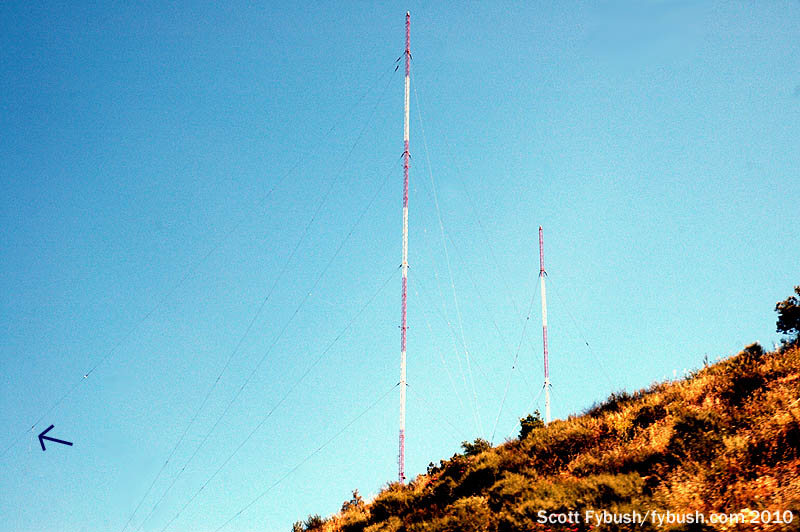
How”s that again? Yup – this is one of those rare setups with more directional elements than actual towers. Yes, there are two normal guyed towers here, 257 feet and 309 feet tall, but it takes some careful examination to find “tower 3,” which consists of nothing more than a stout steel wire strung up between a base insulator and one of the guy wires leading from the top of tower 2 way down the side of the hill that slopes steeply to the side of the Glendale Freeway (CA 2).
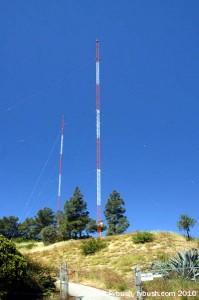

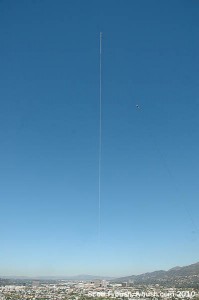

(You can see the top of “tower 3” marked by the blue arrow in the photo above – and don”t forget that you can now click on the smaller pictures in every Site of the Week installments, like the one at right, to enlarge them.)
Hanging down there near the bottom of the guy wire, “tower 3” is considerably shorter than the two real towers here, just 141 feet tall (45 electrical degrees), with 23 additional degrees of top-loading coming from a segment of the support wire to create a 78-degree element that nearly matches the 79.6-degree tower on the other edge of this dog-leg array.
But let”s back up for a moment to examine the history of this curious site and this curious station. The site at Eagle Rock wasn”t originally built for AM use at all – at about 868 feet above sea level, it first found use as an FM site in 1956, when the Maple Chapel in Glendale (later Dr. Gene Scott”s “Faith Center”) put KHOF on the air from here at 99.5 on the dial. (You can read much more about KHOF”s early history at the detailed Faith Broadcasting Network history site put together by former KHOF-FM/TV engineer Joe Snelson, who went on to become the corporate engineer for the Meredith TV stations and a leader of the Society of Broadcast Engineers.)
But KHOF didn”t stay here long; after not much more than a decade at Eagle Rock, the FM signal moved to the higher Flint Peak site about two miles away, setting the stage for this location to become an AM facility.
Its new occupant was a venerable station that had long lived on the fringes of Los Angeles radio. KIEV started out in 1933 as a 100-watt daytimer on 850, operating from studios in the basement of the Glendale Hotel and a longwire antenna behind the building, strung between two towers salvaged from KNX. It moved to 870 in 1941 and eventually upgraded to 500 watts and then to 5000 watts, but still as a daytimer, playing country music in the 1960s and then doing talk in the 1970s and “80s. LA broadcast historian Jim Hilliker says it was 1971 when KIEV moved from the flat-top antenna at the hotel (which remained in use as an auxiliary site) to Eagle Rock, operating as a 5000-watt non-directional daytimer.
After an abortive attempt to go to two-site operation with a night signal diplexed from the KIIS (1150) site at Montecito Heights, KIEV”s big upgrade finally came in 1984, when the station became a full-time directional signal from Eagle Rock, erecting the current two-tower array and adding a 1000-watt night signal that protected what had until then been the only North American 870 signal at night, WWL in New Orleans. (The channel later got much busier, adding other nighttime 870s as close in as Las Vegas, but that”s another story.) KIEV”s daytime signal increased to 10,000 watts from the new Eagle Rock DA, eventually bumping up to 15 kW and then 20 kW.
The station eventually ended up in the hands of Salem Communications, which changed its calls in 2001 to KRLA, a heritage callsign long at home in Southern California on the Pasadena-licensed 1110 signal – and Salem made further upgrades to the 870 signal. From Eagle Rock, KIEV/KRLA couldn”t do much to improve its eastward signal, but it had the potential to put a much more potent signal over the huge population base of the LA basin spreading out to the west and south…as long as one obstacle could be pulled out of the way. That was the 50,000-watt signal on 870 in Hawaii, KAIM, and it ended up in Salem”s fold, too, which cleared the path for KAIM to be moved to 880 (and relocated from an expensive diesel-powered directional array on Molokai to a less-expensive nondirectional site in Honolulu) and for KRLA to upgrade.
At one point, Salem looked at moving KRLA”s night signal to the 1110 site (the former KRLA!) in El Monte to the east, which would have yielded a 20-kilowatt nighttime facility aimed west over more of the LA metro, but instead 870 stayed put at Eagle Rock fulltime. The addition of “tower 3” allowed KRLA to power up to 50 kilowatts by day and 3,000 watts at night, an upgrade that also forced an addition to the original 1956 building. The night transmitter (a Nautel AMPFET) stayed put in the old building, as did the plexiglas-fronted night phasor, now accompanied by the new day phasor; the new daytime transmitter, a Nautel XR60, went into the addition.
In its current incarnation, this is an unusual site to visit. The approach comes up from the west, up winding residential streets that dead-end at the site gate, where a narrow road winds up the hill to the transmitter building that sits between the two “real” towers. Getting to “tower 3” requires a long walk through the brush behind the building, then a fairly steep downhill climb down steps that lead to the fenced-in “tower base” enclosure just above the rushing traffic of the Glendale Freeway – but instead of a tower base, of course, it”s just the bottom of the dropped wire attached to an insulator next to the ATU.
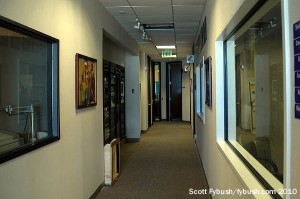

And having checked out all that transmitter-site history, how about a quick peek at KRLA”s studios?
After many years in first the basement and then the third floor of the Glendale Hotel, KIEV moved in the 1970s to an office building on San Fernando Boulevard in Glendale, where the “K I E V” calls can still be seen in the faded stucco. But for the last decade and change, 870 has made its studio home with the rest of the Salem Los Angeles cluster in an office building on Brand Boulevard, just north of the Ventura Freeway.
Salem has most of the fifth floor here, with studios arrayed down two hallways. There”s a pair of studios for KRLA”s talk format and a production room next door that can double as a studio for sister station KTIE (590 San Bernardino), which carries most of the same Salem talkers as KRLA.
Down the hall are the studios for Salem”s religious talker, KKLA (99.5) – and yes, that means the original occupant of the Eagle Rock site is now a sister station to its present tenant. (The 99.5 transmitter site long ago migrated from Flint Peak up to Mount Wilson.)
And then there”s the most unusual studio in the cluster – and perhaps in all of southern California. Despite a fairly tiny class A signal centered on Orange County, KFSH (95.9 La Mirada) has built a pretty big name for itself as contemporary Christian “95.9 the Fish,” the biggest of Salem”s “Fish” stations around the country, and so when it came time to renovate the studio, Salem”s engineers and architects had a great, er, “maritime” with the project.
There”s frosted “seaweed” on the floor-to-ceiling studio windows, making it look a little like an aquarium, and inside the studio the racks to the left of the board are mounted in a LED-festooned fish that matches the fish-shaped guest table to the right of the console.
Thanks to Salem”s Bill Sheets and Hal Williams for the tours, and to Jim Hilliker for the history!
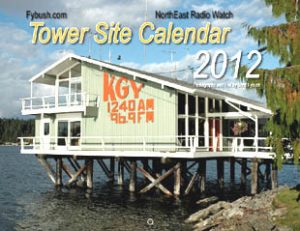

And check out our sister site, Tophour.com, beginning Wednesday, February 8, for LA legal IDs…
Next week: Still more Los Angeles, 2010
In this week’s issue… Yankees hire Dave Sims - Wallace, Maxwell move in NYC - Gray cuts news in Maine - Remembering CT's Pinto By SCOTT FYBUSH Jump to: ME - NH - VT - MA - RI - CT...
In this week’s issue… iHeart axes Boston, NYC morning shows and more - Cumulus cuts in central PA - Southern Tier combo saved from silence - Ottawa FM relaunches - K-Love buys in the Burgh - Scranton gets "Loud" -...
In this week’s issue… "Hot" cools down in Providence, CT studios closed - GBH to sell Cape studios - A HEBA in Hamden? - New HDs in New York - Another Canadian AM to close
In this week’s issue… GBH shuffles mornings, prepares new show launches - NYSBA inducts Hall of Famers - More news-talk in the Hudson Valley - Remembering Dan Sys